
Research and Practice in Thrombosis and Haemostasis
Scope & Guideline
Innovating hematology through open-access insights.
Introduction
Aims and Scopes
- Thrombosis and Hemostasis Disorders:
The journal emphasizes research on various thrombotic and bleeding disorders, including venous thromboembolism, hemophilia, and acquired bleeding disorders. This includes the exploration of their underlying mechanisms, risk factors, and clinical outcomes. - Innovative Therapeutics and Management Strategies:
A significant focus is placed on the development and evaluation of new therapeutic interventions, including direct oral anticoagulants, novel factor therapies, and patient-centered management strategies in thrombosis and bleeding disorders. - Clinical Guidelines and Practice Patterns:
The journal addresses the implementation of clinical guidelines and practice patterns in managing thrombosis and hemostasis, with a keen interest in how these guidelines affect patient outcomes and healthcare practices. - Translational Research and Technology Integration:
Research articles often explore the integration of advanced technologies, such as machine learning and patient-reported outcomes, into clinical practice to enhance diagnosis, treatment, and understanding of thrombosis and hemostasis disorders. - Population Health and Epidemiology:
The journal investigates the epidemiology of thrombotic events and bleeding disorders, particularly in diverse populations, and how social determinants of health influence outcomes in these conditions.
Trending and Emerging
- Patient-Centered Outcomes and Quality of Life:
There is an increasing emphasis on research that evaluates patient-reported outcomes and quality of life in individuals with thrombosis and bleeding disorders, focusing on how treatments impact daily living and overall well-being. - Use of Machine Learning and AI in Thrombosis Research:
Emerging studies are leveraging machine learning and artificial intelligence to predict thrombotic events, optimize treatment protocols, and personalize patient care, indicating a significant shift towards data-driven approaches. - Thrombo-inflammation and COVID-19:
Research exploring the intersection of thrombo-inflammation and COVID-19 has surged, focusing on how the pandemic has altered the landscape of thrombosis and hemostasis management. - Diversity and Health Disparities:
There is a growing focus on understanding health disparities in thrombosis and bleeding disorders, particularly how race, ethnicity, and socioeconomic status influence outcomes and treatment access. - Innovative Antithrombotic Therapies:
Research on novel antithrombotic therapies, including bispecific antibodies and gene therapies, is on the rise, reflecting advancements in treatment strategies for managing complex coagulation disorders.
Declining or Waning
- Traditional Anticoagulation Therapies:
Research on older anticoagulation therapies, such as low molecular weight heparins and vitamin K antagonists, is less frequently published as attention shifts toward newer direct oral anticoagulants and more innovative treatment options. - Basic Laboratory Techniques:
There is a waning interest in basic laboratory techniques and assays that have been standard for years, as the field increasingly favors novel methodologies and technologies that provide more precise and clinically relevant data. - Single-Center Studies:
The prevalence of single-center studies appears to be decreasing, with a trend toward multicenter and international studies that offer broader insights and higher generalizability. - Case Reports and Small Case Series:
The journal has seen a reduction in the publication of case reports and small case series, likely due to a preference for larger studies that provide more robust evidence.
Similar Journals

JOURNAL OF THROMBOSIS AND THROMBOLYSIS
Transforming understanding of blood disorders.JOURNAL OF THROMBOSIS AND THROMBOLYSIS, published by Springer in the Netherlands, serves as a vital platform for research in the fields of Cardiology and Cardiovascular Medicine and Hematology. With an impressive impact factor, this journal ranks in the Q2 category for both fields according to the latest metrics, evidencing its significant influence and contribution to ongoing scholarly discourse. Spanning over three decades from 1994 to 2024, the journal provides an essential source for innovative studies, clinical practices, and comprehensive reviews related to thrombosis and thrombolysis. Researchers, clinicians, and students alike will find valuable insights and cutting-edge knowledge that address the complexities of blood coagulation and its implications in cardiovascular health. The journal is indexed in Scopus, with commendable rankings, further establishing its reputation in the academic community.
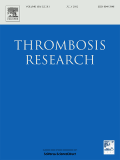
THROMBOSIS RESEARCH
Elevating Hematology Through Rigorous ResearchTHROMBOSIS RESEARCH is a leading peer-reviewed journal in the field of hematology, published by PERGAMON-ELSEVIER SCIENCE LTD. With an impressive impact factor and ranked within the top 10 of 137 in its category according to Scopus, this journal provides a critical platform for the dissemination of innovative research related to thrombosis and hemostasis. Established in 1972, THROMBOSIS RESEARCH has been at the forefront of scholarly communication, addressing key issues, findings, and advancements over more than five decades. Recognized for its high-quality content, the journal is categorized in the Q1 quartile for 2023, reflecting its influence and relevance within the scientific community. Researchers, medical professionals, and students engaged in the study of blood disorders will find valuable insights and the latest discoveries within its pages. Although currently not an open-access publication, THROMBOSIS RESEARCH remains accessible to a wide audience through institutional subscriptions, ensuring that vital research continues to inform and enhance clinical practices around the globe.

Hematology Reports
Exploring breakthroughs in blood health.Hematology Reports is an esteemed academic journal in the field of hematology, dedicated to advancing the understanding of blood disorders and their treatment. Published by MDPI, a leading Swiss publisher known for its commitment to open access since 2009, this journal provides a valuable platform for researchers and healthcare professionals to disseminate innovative findings and foster collaboration within the academic community. The journal features an array of articles ranging from clinical studies to laboratory research, and is indexed in Scopus, where it currently holds a rank of 113 out of 137 in the Medicine - Hematology category, placing it in the 17th percentile. As an open-access journal, Hematology Reports ensures that critical research is accessible to a global audience, supporting the dissemination of knowledge that has the potential to improve patient outcomes. This journal is an essential resource for those engaged in the study and treatment of hematological conditions, encouraging dialogue and the exchange of ideas to enhance clinical practices.

ANNALS OF HEMATOLOGY
Connecting researchers and clinicians for a healthier tomorrow.ANNALS OF HEMATOLOGY, published by Springer in Germany, stands as a premier platform for advancing knowledge in the field of hematology and medicine at large. With a significant impact factor and recognized rankings—Q2 in Hematology and Q1 in Medicine (miscellaneous) as of 2023—this journal is pivotal for researchers, clinicians, and students who are keen on exploring the latest developments in blood disorders, treatments, and innovative methodologies. Its broad scope encompasses original research, reviews, and discussions that aim to foster interdisciplinary dialogue, ensuring that the latest findings and theories are accessible to the scientific community. Although not an open-access journal, its rigorous peer-review process guarantees high-quality contributions, thereby solidifying its reputation as a vital resource in the hematological field. Founded in 1991, the ANNALS OF HEMATOLOGY continues to evolve, converging invaluable insights from both basic and clinical research until 2024. For those dedicated to improving patient outcomes and advancing hematological science, this journal remains an essential reference.

Blood Research
Transforming Knowledge into Clinical ExcellenceBlood Research, published by SPRINGER, is a premier journal dedicated to the multifaceted realm of hematology, serving as a crucial platform for disseminating innovative research findings and advancements in the diagnosis and treatment of blood-related disorders. With an ISSN of 2287-979X and an E-ISSN of 2288-0011, this journal is recognized for its commitment to scholarly excellence and impact in the field, currently holding a reputable Q2 ranking in the Hematology category as per the 2023 metrics. The journal spans from 2013 to 2024, providing a broad archive of quality research that is vital for researchers, healthcare professionals, and students alike. Although it is not an Open Access journal, it offers insightful contributions that enhance the understanding of hematological science, fostering the exchange of knowledge crucial for advancing patient care and clinical practices globally. The journal’s performance is underscored by its Scopus ranking in the 46th percentile, reflecting its significant role in the ongoing discourse in hematology.
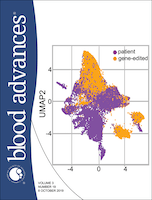
Blood Advances
Unveiling the Future of HematologyBlood Advances is a premier, peer-reviewed journal published by Elsevier, dedicated to the field of hematology. With an impressive impact factor and classified within the Q1 category of hematology for 2023, it ranks as the 16th out of 137 journals in the Scopus Medicine Hematology category, placing it in the top 88th percentile globally. This influential journal, which has been disseminating invaluable research since its inception in 2017, focuses on advancing knowledge and innovation in blood science, including clinical and laboratory aspects of hematology. Although it offers limited open access features, its comprehensive scope encompasses various topics relevant to both researchers and practitioners. Located in the United States and managed from Amsterdam, Blood Advances provides a vital platform for the dissemination of groundbreaking research, making significant contributions to the understanding and treatment of blood disorders. Researchers, professionals, and students alike will find this journal an essential resource for keeping abreast of the latest developments and advancements in hematology.
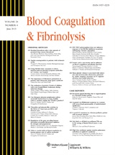
BLOOD COAGULATION & FIBRINOLYSIS
Exploring Innovations in Blood HealthBLOOD COAGULATION & FIBRINOLYSIS, a distinguished journal in the field of hematology, is published by Lippincott Williams & Wilkins, a reputable name in academic publishing. Since its inception in 1990, this journal has been committed to advancing the understanding of blood coagulation and fibrinolysis, focusing on the molecular mechanisms, clinical implications, and therapeutic aspects of these critical processes. With an impact factor reflecting its significance within the academic community, currently ranking Q3 in both Hematology and Miscellaneous Medicine for 2023, this journal serves as a pivotal platform for researchers and professionals alike. By providing access to cutting-edge research and reviews, BLOOD COAGULATION & FIBRINOLYSIS endeavors to foster collaboration and innovation in the treatment of coagulation disorders. Interested readers can explore ongoing contributions to the field through subscriptions and institutional access options.
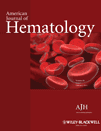
AMERICAN JOURNAL OF HEMATOLOGY
Connecting Scholars to Shape the Future of HematologyAmerican Journal of Hematology, published by Wiley, stands as a premier outlet for the dissemination of cutting-edge research in the field of hematology. With a commendable impact factor and ranked #9 out of 137 in the Scopus medicine category, this journal has established a robust presence since its inception in 1976. Operating in the Q1 quartile for hematology, it serves as a crucial resource for researchers, clinicians, and students dedicated to understanding blood disorders and advancing treatment methodologies. While the journal does not currently offer open access options, it remains highly regarded for its rigorous peer-review process and impactful contributions to the scientific community. With coverage extending into 2024, the American Journal of Hematology is committed to fostering innovation and collaboration within the hematological sciences.
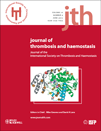
JOURNAL OF THROMBOSIS AND HAEMOSTASIS
Advancing the Science of Blood HealthJOURNAL OF THROMBOSIS AND HAEMOSTASIS, published by Elsevier Science Inc, stands at the forefront of research in the fields of hematology and medicine, boasting an impressive ranking of #5 out of 137 in Scopus's Medicine - Hematology category, with a remarkable 96th percentile. As an essential resource for researchers, clinicians, and students, this journal, identifiable through its ISSN 1538-7933 and E-ISSN 1538-7836, encompasses pioneering studies and reviews that focus on the mechanisms of thrombosis and hemostasis, contributing significantly to advancements in patient care and therapeutic strategies. With an established presence from 2003 through 2024, it has consistently achieved a prestigious Q1 category ranking, reflecting its impactful contributions to the scientific community. Although it operates under a subscription-based model, the journal remains committed to disseminating significant findings that inform best practices in clinical settings and shape future research trajectories.
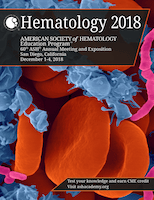
Hematology-American Society of Hematology Education Program
Navigating the Future of Hematology TogetherHematology-American Society of Hematology Education Program is a premier peer-reviewed journal dedicated to advancing the field of hematology through comprehensive educational content. Published by the American Society of Hematology, this journal plays a crucial role in disseminating knowledge to researchers, clinicians, and students in hematology and related disciplines. With an impressive Q1 status in the field, it ranks among the top journals at the forefront of hematological research, as evidenced by its 60th percentile ranking in Scopus' Medicine - Hematology category. Although it does not offer open access, the journal provides invaluable insights and educational resources from leading experts, focusing on the latest advancements, treatment protocols, and evolving understanding of blood disorders. Covering a wide range of topics, from basic research to clinical applications, this journal is essential for anyone seeking to deepen their expertise and stay informed on the latest developments in hematology. For further engagement, readers can access insightful articles published since 2001, ensuring a rich repository of knowledge for ongoing research and clinical excellence.